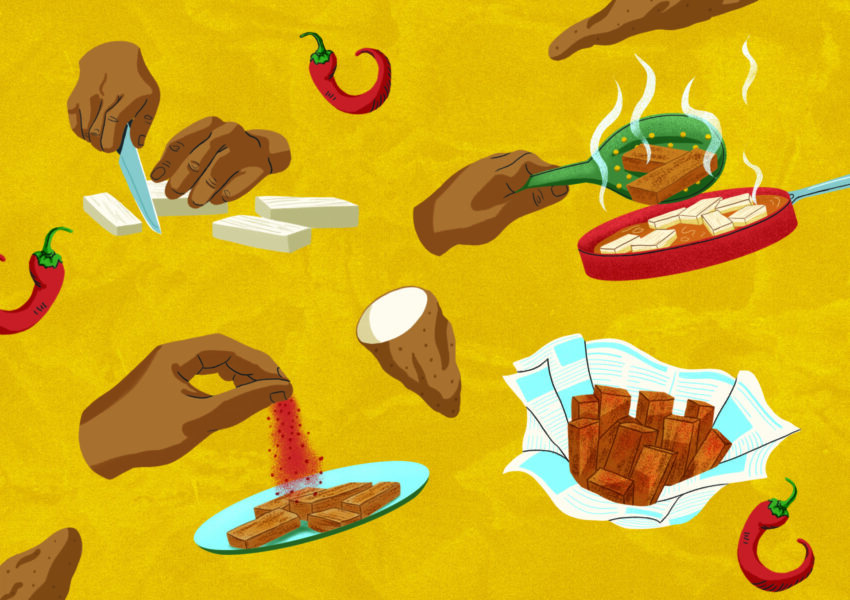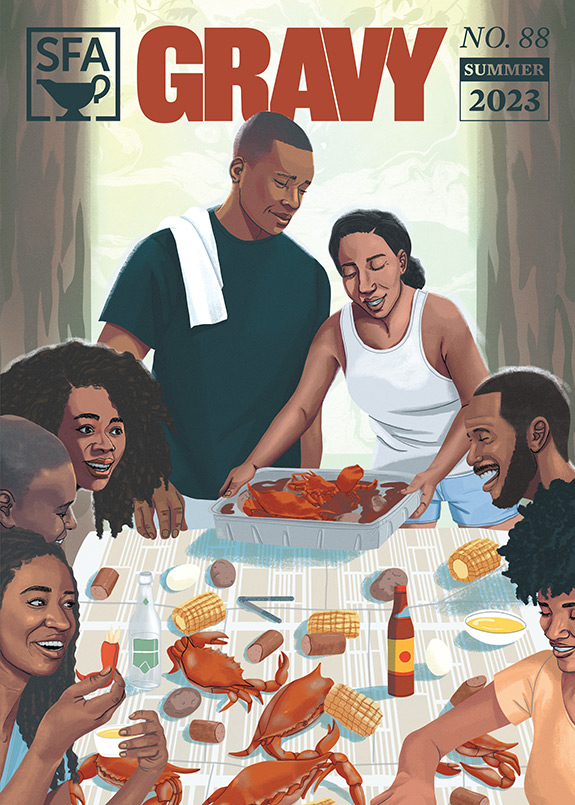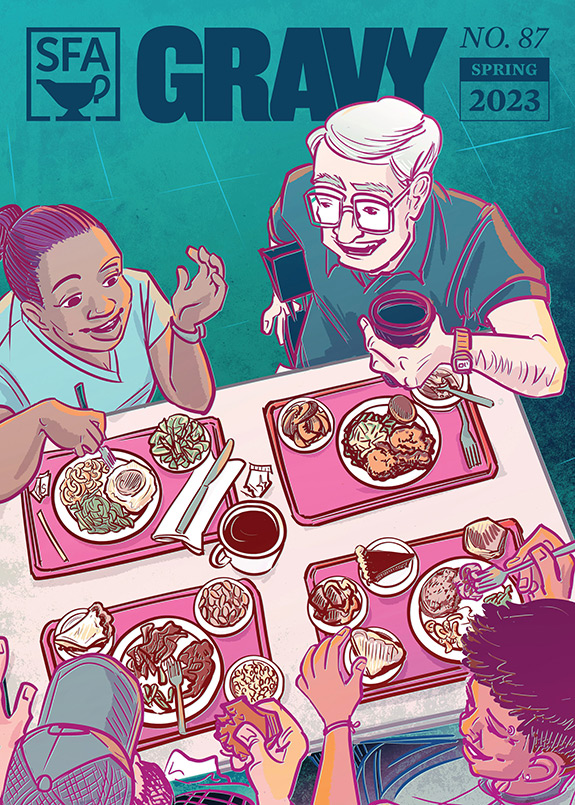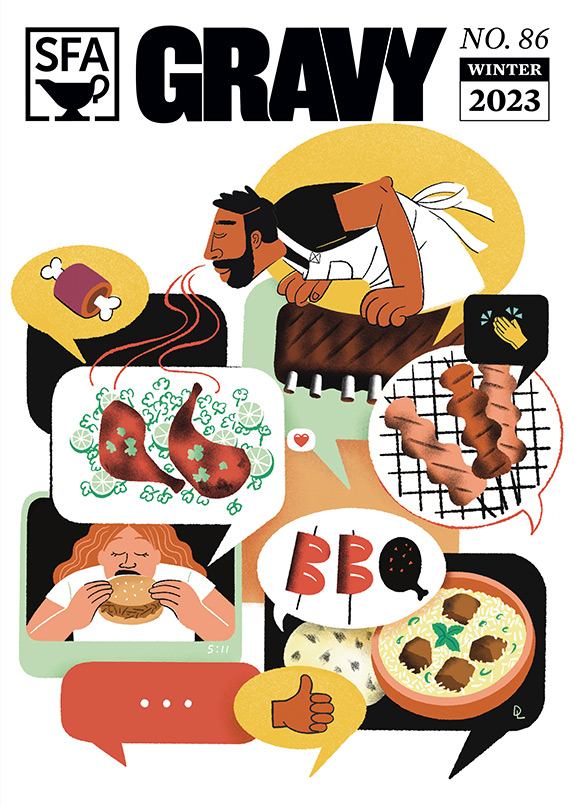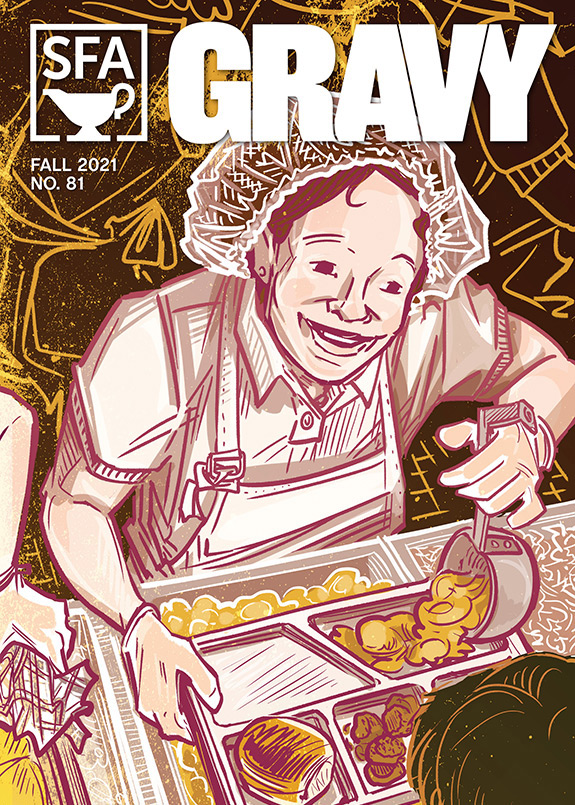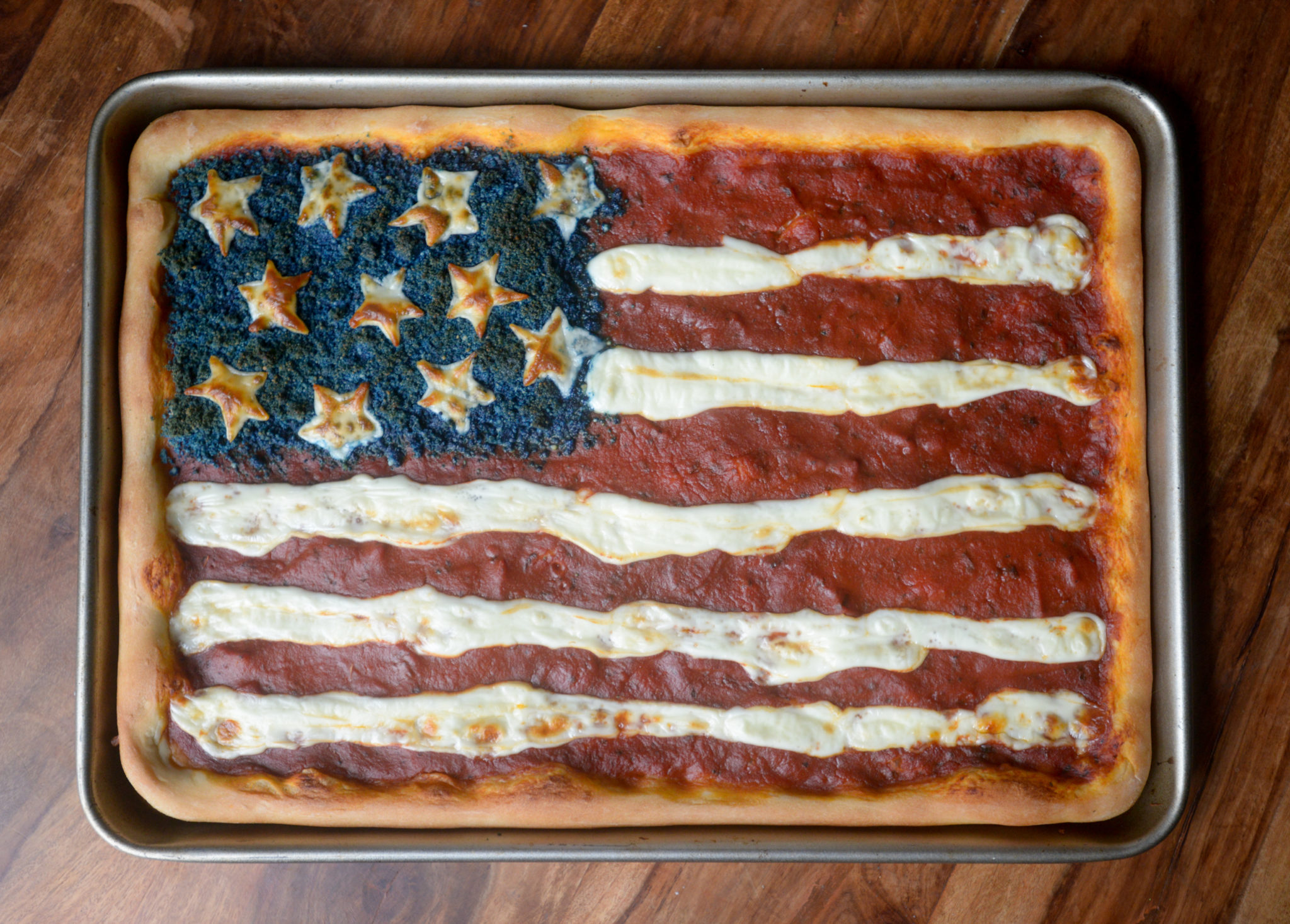
This story first appeared in the winter 2015-16 issue of our Gravy quarterly. The author, Chris Offutt, is a Kentucky native who lives in Oxford, Mississippi. His newest book, My Father, the Pornographer, is out this week.
Join or renew your SFA membership to receive a subscription to Gravy in print. Thanks to SFA members, whose support helps make Gravy possible.
Flag Pizza
No History Anyone Should Be Proud Of
by Chris Offutt
A while back I lived on a river and got around in a dented johnboat with a six-horsepower engine. I was mostly broke during those years and bought the boat used. For an anchor I embedded an eye-bolt in a coffee can with cement, then tied a rope to the bolt. Mainly I cruised upriver then let it drift back.
An old friend visited one weekend and we took the boat out on a very hot day. Bruce is a big guy from eastern Washington, descended from outlaws and lawmen. Accustomed to a colder climate, Bruce removed his shirt and hung it on the wooden post that served as my dock. We filled the tank and headed downriver, farther than I’d ventured alone. We drifted, stopping now and again to investigate debris, and ran out of beer. At a wide, slow curve was a tavern overlooking the water.
We made land, climbed the bank, and entered through the back door. Everyone stopped talking and looked at us. We were muddy, and Bruce wore nothing but cut-off shorts and flip-flops. As our eyes adjusted to the dim light we realized that it was a biker bar filled with tough men in leather, denim, and an occasional head scarf. No one spoke. The bartender had his hands out of sight below the bartop, no doubt a weapon at the ready.
Bruce was as big as any of the bikers, but I was the smallest man there. In a scuffle, I could maybe beat up the jukebox with a chair. I moved to the bar, sensing everyone’s eyes, and spoke: “We came by boat. Like to get a couple of beers.”
“Boat,” the bartender said.
I nodded and someone went out the back door to confirm our mode of transportation. A tall man came my way, his bare arms scrolled with jailhouse tattoos. I waited calmly. In my experience, big men don’t mess with little guys. It’s usually the other way around, and he might have been testing me in case I was one of those Napoleon-types who needed to prove himself. Fortunately for all of us, I am not.
“Yes, a boat,” I said. “We came from down past the woods where those wrecked cars are holding the bank from washing out. Ran out of beer.”
The big guy put his arm over my shoulders. It felt like a load of lumber. “Anybody who don’t drive a car can drink with me,” he said. “Set ’em up.”
“Can’t,” the bartender said. “Law says they got to wear a shirt. I been warned twice. Next time they’ll shut us down.”
“All righty,” the guy said. “Somebody give him a shirt. Big Girl, you still got that one on your sissy bar?”
A huge man from the back of the bar went outside. The bartender put two bottles of Bud on the counter, and I realized I didn’t have my wallet. While I was worrying about that, the giant came back carrying a tattered gray T-shirt. The front was emblazoned with an American flag and the words “Try burning this one!”
We stayed about an hour, during which we drank for free and learned that “Big Girl” was actually “Big Earl,” and anyone who said it wrong got stomped. I made sure to enunciate his name carefully, speaking like someone new to language. Bruce kept the shirt when we left. The next time I went to the bar, it was permanently closed.
Bruce visited me in the mid-1990s, when the issue of flag-burning was in the news, on television and the radio. Throughout the 1970s, nearly half the states passed laws that barred flag desecration, focusing on physical misuse such as mutilation. By 1989, the Supreme Court ruled that damaging the flag was protected by free speech. In the 1990s, flag-burning became trendy again. Politicians attempted to amend the Constitution and make burning the flag illegal. The legislation didn’t pass.
In the hills of eastern Kentucky where I grew up, I walked through the woods to school. Each classroom contained the Bible, a picture of George Washington, the Kentucky flag, and an American flag. After the teacher called the roll, all of us stood beside our desks and recited the Pledge of Allegiance, then the Lord’s Prayer. My mother had a large plastic American flag that she displayed on patriotic holidays.
One of my childhood chores was carrying firewood in winter to heat the house. The other was burning the household garbage twice a week. I regarded fire as a practical matter with a distinct purpose. Flags were easy to get and very flammable, which made burning one simple. I never understood the impulse to do so.
After Bruce left, I had many thoughts. What if you made the flag yourself? Suppose it was colored in crayon on paper, not really a flag, but a representation of a flag? Would Bruce go to jail if he burned the T-shirt?
I have attended dozens of Independence Day celebrations, typically cookouts in backyards. Often a cake is decorated to resemble a flag. For a group of children I once made an oblong pizza that depicted the American flag, using food coloring for the blue field of stars with alternating stripes of cheese and tomato sauce. My wife said it was the ugliest pizza she’d ever seen, but I didn’t mind. The kids loved it. First, they picked out the Parmesan stars, then started on the rest. Essentially, they desecrated the flag by eating it. Who, then should be arrested—me for making it? The children who ate it? The host of the party where the crime took place? Or the parents, for allowing their kids to mutilate the flag by mastication?
—
I moved to Mississippi five years ago, unable to recognize the state flag from the other 49. I assumed that the university nickname of “Ole Miss” was an affectionate term shortened from “Ol’ Mississippi.” As it turns out, “Ole Miss” was the term slaves used for the wife of plantation owners in the Deep South. The owner was often known as “Ole Massa” or “The Colonel.” Shortly before my arrival in Oxford, the school administration changed the sports mascot from Colonel Reb to a bear. Traditionalists were very upset, and many still are. Colonel Reb’s image continues to appear all over town—a cartoon drawing in a red or blue coat with formal tux tails and red trousers. As a Kentuckian, I didn’t understand the controversy but recognized that it was a deep rift.
In Mississippi, I learned that all my life I’d wrongly used the term “Stars and Bars” to refer to the traditional rebel flag. That name designated the first flag of the Confederacy, with a circle of stars in the upper left quadrant. It was very similar to the Star Spangled Banner carried by Northern troops. The resemblance created such confusion on the battlefield that Confederate General P.G.T. Beauregard demanded a new banner. The second and third official flags of the Confederacy included the Southern Cross in the upper left corner—a blue X containing thirteen stars on a field of red. Most of the flag was white, which proved problematic. Lacking wind, the cloth hung limp and looked like a flag of surrender. The result of these clumsy designs was the widespread use of the battle flag of the Northern Virginia Army. It proved recognizable due to its large Southern Cross on a solid red expanse.
In 1894, politicians added the Southern Cross to the Mississippi state flag. Due to political ineptitude, the flag was not formally adopted until 2001. Today it is the only state flag that retains an image of the Confederate battle flag. Recently it has been the subject of newspaper editorials, radio talk shows, and shrill “debates” on social media. The difference of opinion is simple. What does the Southern Cross stand for: slavery or history? The University of Mississippi student senate recently voted to stop flying the flag on campus, and the faculty senate concurred. The flag no longer appears on the grounds of the state’s flagship university.
My own relationship with the Confederate battle flag is complicated. In the early 1970s, I was a rebellious teenager in a town of 200 deep in the hills of Kentucky. I wore a Levi’s jacket with an embroidered patch sewn on each shoulder: One was the peace sign and the other was the Confederate battle flag. Older boys in high school drove muscle cars, their rear windows draped with the rebel flag. Everyone had an eight-track tape player wired to large speakers that played Lynyrd Skynyrd, The Allman Brothers, and Marshall Tucker. We had guns and long hair and considered ourselves outlaws. People in town didn’t like us and we didn’t like them. The rebel flag embodied our sense of exclusion from conventional society. We didn’t care what the Confederacy was rebelling against, only that the flag was a formal sanction of rebellion.
I left the hills with this identity, drifting from state to state and city to city. I read and wrote, published books and had children. I bought a house. My hair turned gray. I wore glasses and taught college. Nevertheless, that outlaw identity—and its music—stayed with me. None of us at home had associated the flag with either history or white supremacy. There were no slaves in the hills. Most families barely had enough income to maintain a vehicle and clothe their children. Nobody ever had the money to own another human being.
These days I understand more about the flag than I did as a teenager, but I don’t look back with shame. I learned a long time ago that growing up in rural isolation meant that I was an ignorant country boy. There’s no shame in lack of knowledge. It’s normal. Everyone has to learn, either from family or teachers or experience. The only true shame lies with people who willfully maintain their ignorance despite information; people who don’t alter their perspective with age and maturity. Many of these people rely on the past because they’re disappointed with their own present circumstances. That’s a damn shame.
I’ve always been proud of the Kentucky flag, which depicts two men shaking hands—one wearing the buckskins of the hills, the other a flatlander in a suit. If that image were subject to change, I’d be adamant in its defense. I love that flag and hang one in my writing room. The state motto, “United We Stand, Divided We Fall,” is not offensive so much as it is an outright lie. Men in suits never shake hands with hill people. State politicians don’t give two whits about us. Their goal is seldom serving the people. They pass laws they don’t follow, raise taxes, then vote themselves pay raises and take expensive vacations.
After moving to Mississippi, I had to revise my thinking about the Southern Cross and its inclusion in the state flag. I talked to opponents and supporters. Both sides made good points. Opponents said it represented the repugnance of slavery and a wrong-headed belief in white supremacy. They believed the flag is deeply offensive to many people who live here—white and black.
Supporters of the flag often traced their lineage back to the Civil War, descended from soldiers who’d died because they were courageous young men conscripted into service. Most were from poor families that did not own slaves. Defenders of the flag say it represents history, heritage, and Southern pride. That may be the case for some. But the designer of the original flag wrote that the South was “fighting to maintain the Heaven-ordained supremacy of the white man over the inferior or colored race.” That is no history anyone should be proud of.
The nature of Southern pride is extremely complex. Losing a war is a devastating blow. In addition to death, suffering, and loss of home, it is a humiliating attack on pride. Many brave men fought in the Civil War. In typical Kentucky fashion, my own family lost soldiers on both sides. I am a proud Southerner. I like our cultural traditions of loyalty, respect for elders, and deep attachment to land. I am particularly proud of my own efforts at being a good father, husband, and citizen.
But I am not proud of our nation’s history of slavery. It is our collective shame. Yes, it flourished in the South due to terrain and crop, but Northerners owned slaves as well. Slavery is a deplorable practice, barbaric and criminal. People take great effort to conceal family histories of slave-owning. The actor Ben Affleck had that information expunged from a PBS documentary. These days the same money that once purchased a human being can now buy suppression of that fact.
In regards to keeping the Southern Cross on the Mississippi flag, a common phrase arose among its supporters: “Heritage not Hate.” I gave that a great deal of thought. There is truth that the flag is a significant part of our nation’s heritage. History should not be ignored, lest it be forgotten and lessons never learned. But in the past 30 years, the battle flag of Northern Virginia has become associated with a variety of discriminatory groups, such as the Ku Klux Klan, Skinheads, and Neo-Nazis. If preserving the importance of the flag as heritage was a priority, it should have been protected when hate groups appropriated it. Instead, the people who believed in heritage stood idly by while the flag was used to symbolize abhorrent beliefs and justify criminal behavior.
The phrase “Heritage not Hate” creates a false choice. One does not rule out the other. In today’s world, the Confederate battle flag represents both. It also represents history, which should not be rewritten simply because truth makes us feel unpleasant. Public monuments to dead soldiers are displays of honor regardless of which army the soldiers served. Military museums preserve the artifacts of history such as weapons, uniforms, and the battle flag of the Northern Virginia Army.
Many Mississippians are concerned about the effect the current flag has on business, tourism, and the ability of the University to attract diverse students, faculty, and athletes. It’s not just progressive people who are disturbed by the flag, but some conservatives as well.
A white businessman and native of Jackson told me that 38% of Mississippi’s citizens are black, so there’s nothing to be gained by alienating more than a third of the population. Another friend of mine has run a retail store in Oxford for 30 years. He attends church twice a week, owns guns, votes Republican, and displayed a large Dixie flag in his store for two decades. Upon hearing that its presence might be problematic, he promptly asked his black customers if the flag was offensive. Everyone who answered said yes. He took the flag down. These are pragmatic examples, motivated by economics and social politics. They make sense. But they also view the problem of the flag as exclusively about black people.
Will changing the flag make any difference in the day-to-day lives of Mississippians? No. Not any more than baking a flag pizza could influence a child’s patriotism. Sewing the rebel flag to my jacket as a teenager did not make me a rebel to society. It was a symbol, not an action, but symbols are crucial tools of identity and communication.
The current Mississippi flag has no historical significance other than being 121 years old. It did not exist during the Civil War. If the flag is changed, everyone must maintain a clear view of the reasons. The problem is not that it offends black people. The problem is what the flag says about white people.



